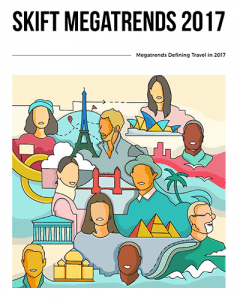Skift Take
The way we dine out has changed — instead of serving just a meal, restaurants have become destinations in their own right. Fueled by the ability to search, sort, discover, and reserve across digital devices, diners can create the ultimate personalized experience any day of the week, and restaurants have evolved to accommodate these cultural changes.
This month we released our annual travel industry trends forecast, Skift Megatrends 2017. You can read about each of the trends on Skift, or download a copy of our magazine here.
Download Your Copy of Skift Megatrends 2017
It is planned for, reserved, scripted. This shift has been happening over time, but has now reached critical mass: dining out is the main event in a night (or day) out.
Restaurants have always been destinations, and as described in our 2016 Megatrend “The Bourdain Effect,” food is a major hook in travel and trip planning. The way we’re eating as a culture has changed, and restaurants have evolved to become destinations in their own right.
Now, though, a restaurant doesn’t have to be a three- (or two- or even one-) star Michelin to become a destination. Local restaurants are embracing this change, creating immersive and curated experiences for patrons rather than simple, expected service. This doesn’t mean complicated strategy or over-the-top themes. Instead, restaurants work hard to create a distinct feel for their specific space and brand. This extends far beyond the big names in big cities or even Noma-like landmarks. It’s places like Orlando’s Cask and Larder, with its pimento cheese and gin and tonic on tap, or Lexington, Kentucky’s Middle Fork Bar and its local bourbon list. Nothing fancy, just unique and satisfying.
Current restaurant design reflects this trend. Restaurants work to create distinctive spaces that not only evoke a custom, “only here” feel, but also create perfect opportunities for image-sharing on social media. This comes in different forms, from quirky menus to unique floor tiles — anything to make a restaurant stand out. In this way, social media has influenced the changing face of restaurants.
The way we plan how and where to dine is changing, too, based on this shift. Thanks to digital technology — mobile devices especially — everyone can access personalized recommen.dations based on preferences from formality to cuisine, location, or even the volume level inside of a restaurant. Startups such as Resy and Reserve in the restaurant-technology space have evolved into full-fledged businesses that blur the lines between restaurant discovery, reservations, and refining of the consumer dining experience. Multiple reservation apps allow diners to find the exact perfect location for a meal. Digital guides and apps from traditional players like OpenTable and Foursquare and even car-services like Uber create lists of places perfect for every occasion.
And, finally, the way we order is influenced by these shifts. The days of salad-entree-dessert are behind us, as chefs create menus that reflect today’s social nature of dining. Often, that translates to shared plates, ordered in rounds, accompanied by drinks. And, of course, the more Instagrammable the plates, the better. After all, if nobody back home knows you ate there, did you really eat there?
Download Your Copy of Skift Megatrends 2017

The Daily Newsletter
Our daily coverage of the global travel industry. Written by editors and analysts from across Skift’s brands.
Have a confidential tip for Skift? Get in touch
Tags: food and drink, food tourism, megatrends 2017, skift table, tourism

